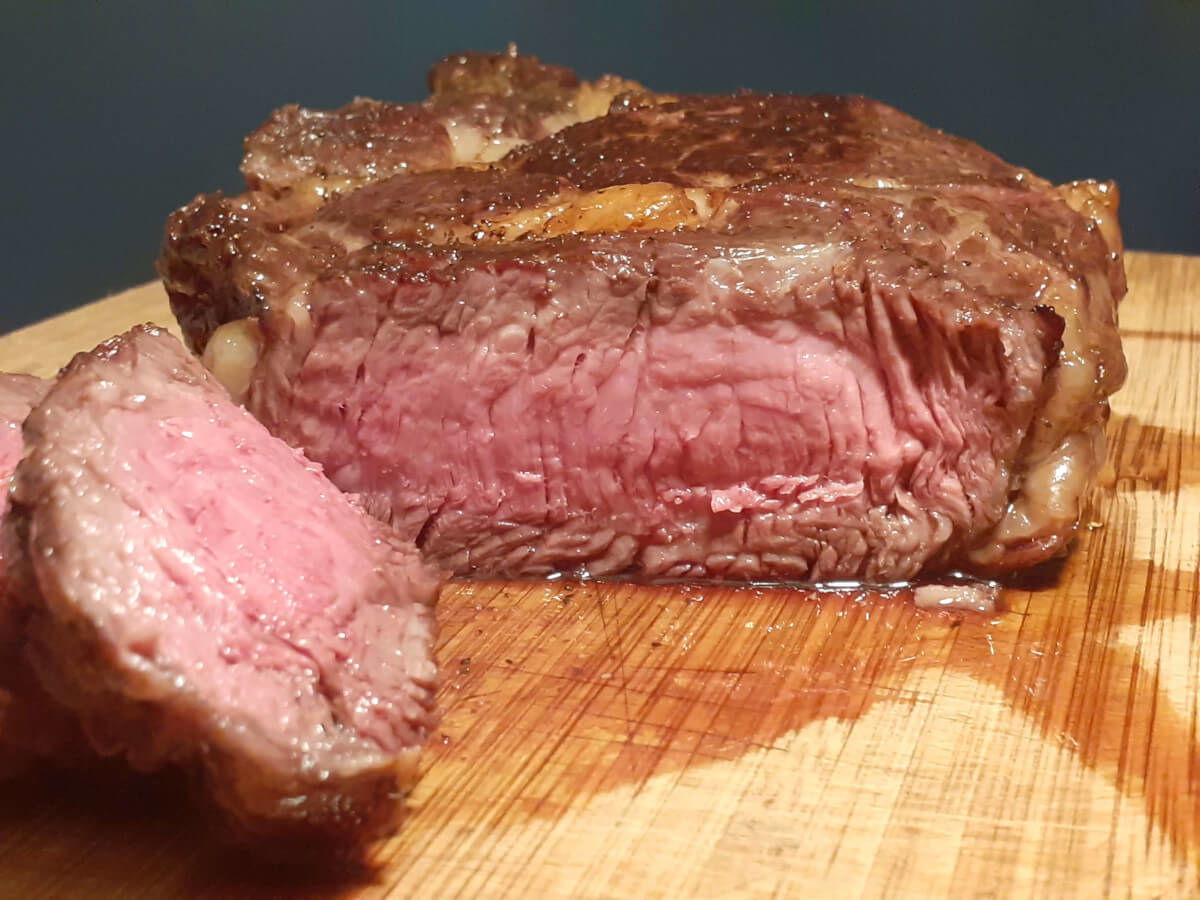I just had too! Cowboy Steaks Seasoned with Kosher Salt & Black Pepper. These bad boys get sliced from a Beef Prime Rib Roast. Seasoned and then rested for a few hours before being cooked.
These Steaks are Gigantic and really hit the spot like nothing else! The side dishes aren’t really needed. You can serve just the Steaks with some Steak Sauce or a variety of Steak Sauces and a Beer.
These are an expensive cut of meat. I was so excited when these went on sale for 1.99 per lbs. Yep for real! These we’re being sold for 1.99 per lbs. with a savings of 15.99 per lbs. Can you believe that! I picked up like 4-5 of these Prime Rib Roasts, each with 3 – 4 bones.
These are a real treat for sure and when cooked just right offer that Juicy Tender Beefiness that can only be found in the Prime Cut. Just Amazing!
Prime Rib Roast
The Prime Rib Roast is the King of all cuts. It is the meat from the Rib section and is usually sold as a roast with 3–4 bones attached. This is also called a Standing Rib Roast or just Beef Rib or Beef Rib Special.
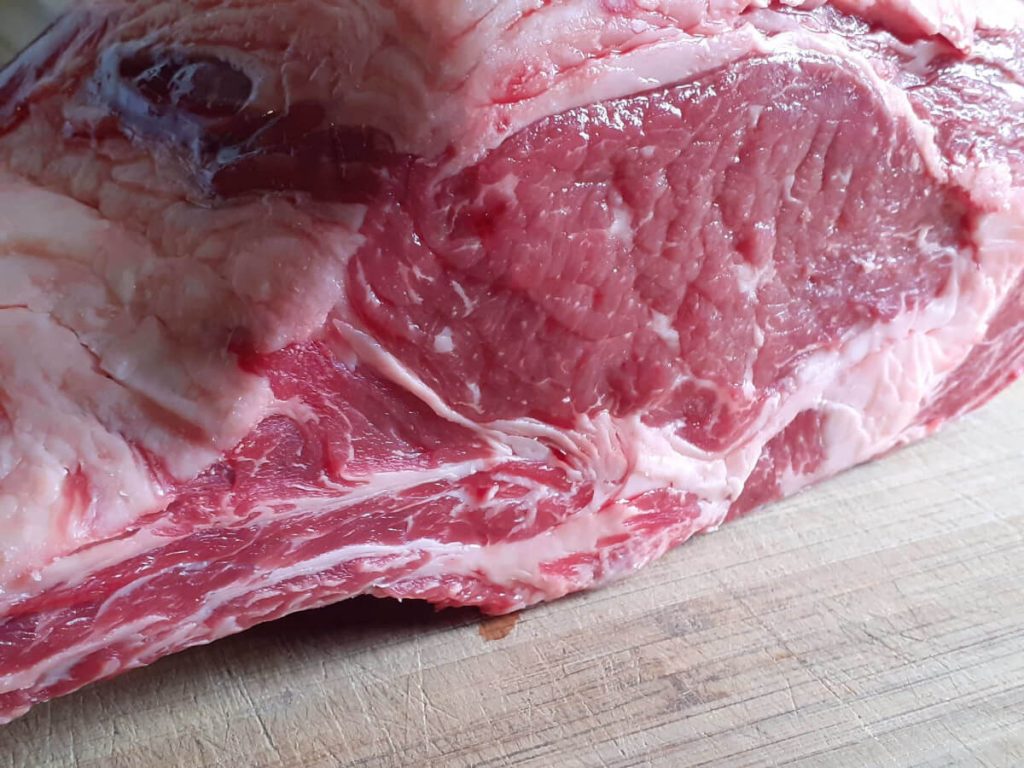
Prime Rib Steak
The Prime Rib Steak or Beef Rib Steak is the Prime Roast that is Cut into Steaks regardless of the Rib Bones. Because of this, they can be cut to any thickness or depth desired. These Steaks can vary on how much bone is cut with the steak, and sometimes contain small bits of bones due to cutting through them.
Cowboy Steaks
The Cowboy Steak is the Prime Rib Roast cut in between the Rib Bones to create thick steaks (Bone in Ribeye) about 2 inches thick. The thickness is dictated by the Ribs. These are also called Caveman Steaks.
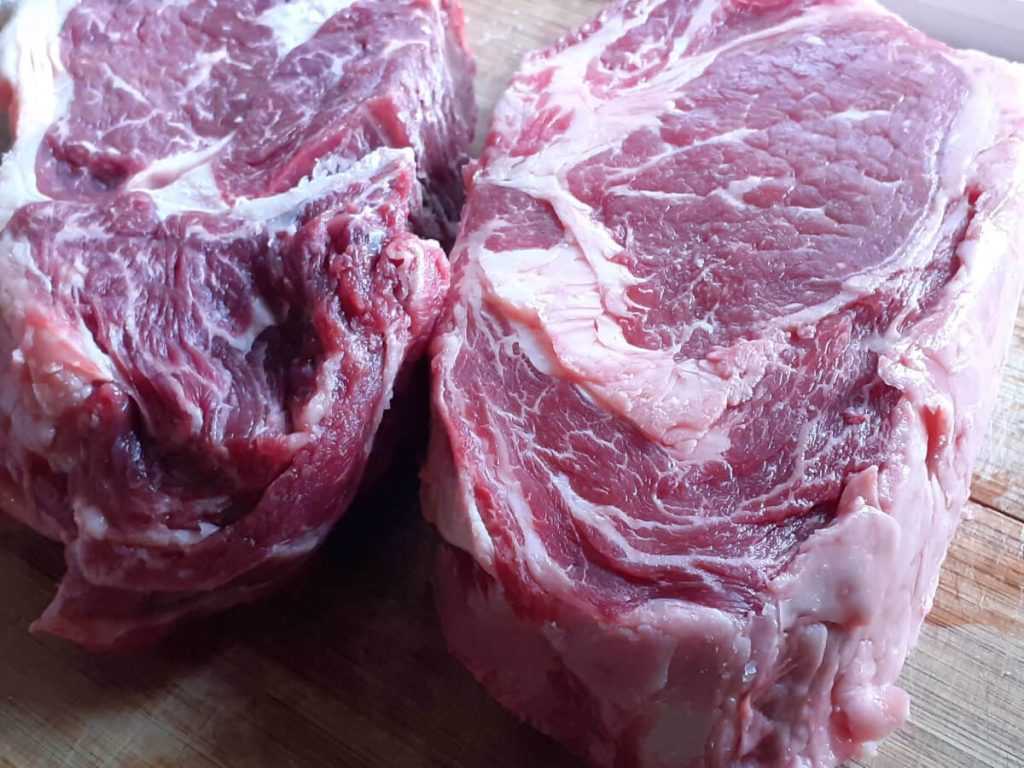
Cowboy Steaks
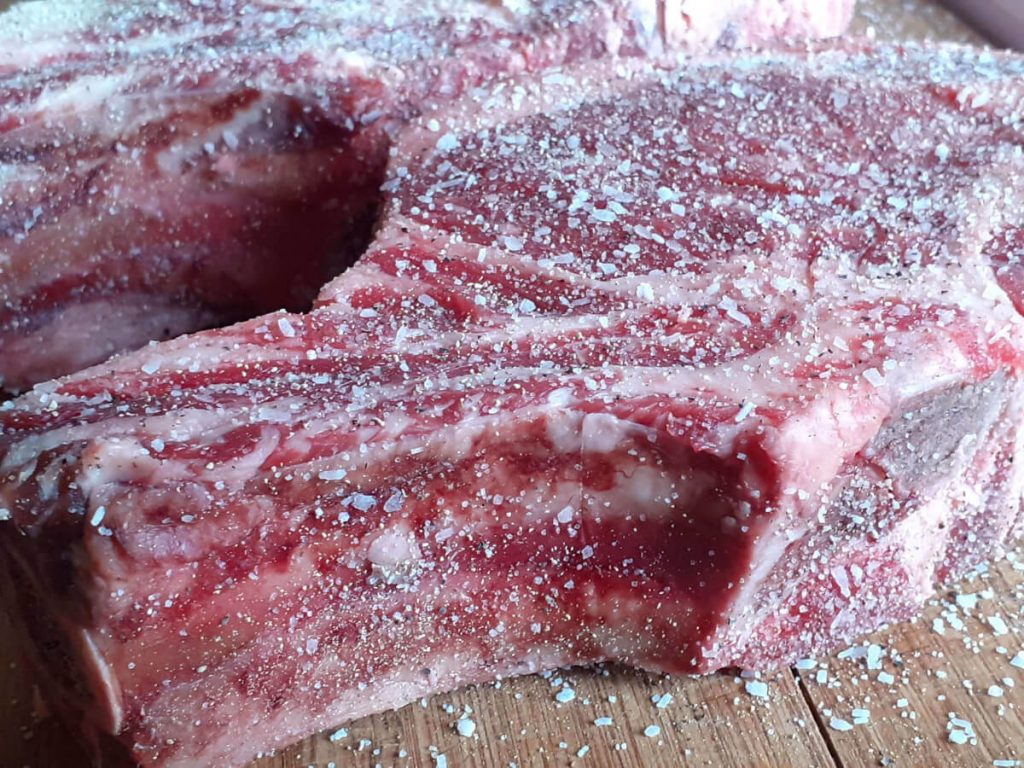
Seasoned Cowboy Steaks
Cowboy Steak Seasoning
Salt & Pepper is all that is really needed. Once seasoned, let them rest at room temp for a few hours or refrigerate overnight. If leaving overnight, take them out a few hours to rest at room temp before cooking. These Steaks are so thick you would be hard-pressed to over season. So be generous with the seasoning.
Typically, Salt & Pepper can go on the steak before they sear. This will eventually get absorbed by the steak. You don’t want to season the steak and immediately cook or shortly after. Allow it time to work.
Additional Seasonings can go on after they sear to avoid being burnt during the searing. More seasoning can be applied after the Steak has been cooked to finish it off.

Salt & Pepper Blend
- 1 Tbl Sea Salt or Kosher Salt
- 1 tsp Black Pepper or freshly cracked Black Peppercorn
- 1/2 tsp White Pepper or freshly cracked White Peppercorn
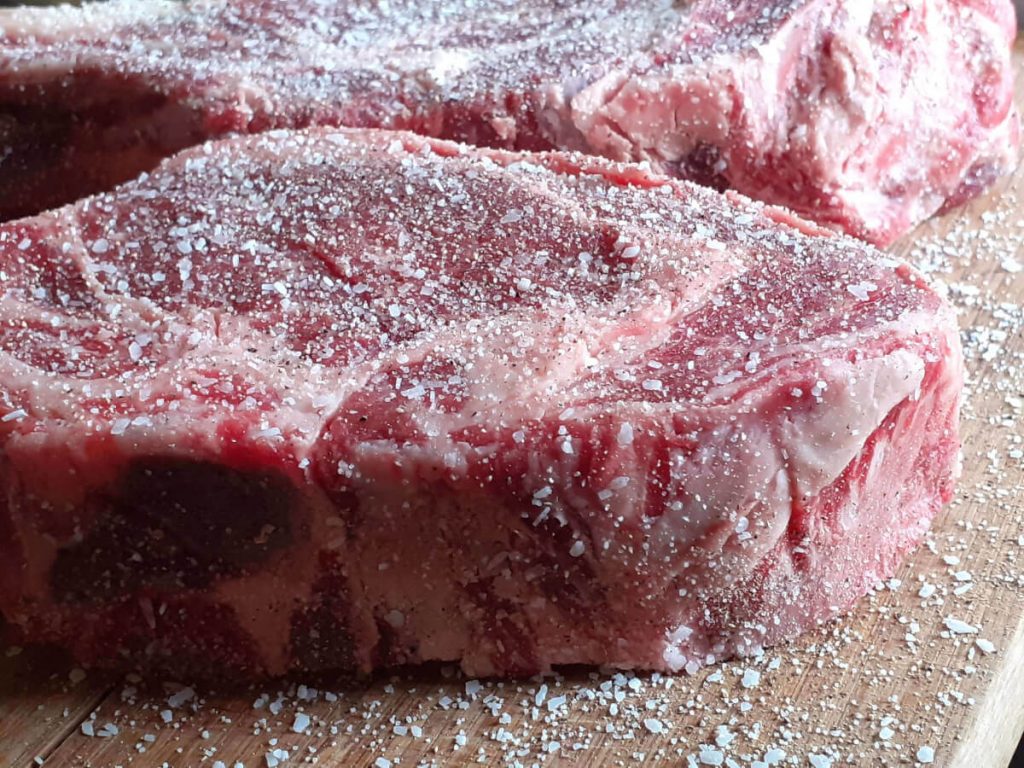
Seasoned Cowboy Steaks
Since these are much thicker cuts, Season generously with Salt & Pepper.

Smoked Salt
The salt can also be replaced with Smoked Salt, or add a bit of Liquid Smoke to the Salt & Pepper blend for that smoke flavor.
Searing Oils
What you are really after is the rendering of Fat that will add flavor and Sear the Steak, and you definitely do not want to continue to cook the steak with Oil or Fats past the smoke point which is why butter is such a poor choice as far as technique goes, not for flavor, sort of, let me explain.
Oils or Fats, when heated past its smoke point, starts to break down. Releasing free radicals and a substance called acrolein, the chemical that gives burnt foods their acrid flavor and aroma. For this reason, it is important to not only sear in fats that have a high smoke point. But to also stay just below that smoke point when searing.
The surface temperature range to aim for when searing is 400-450 F / 204-232 C. So Ideally you want Oils or Fats that don’t smoke off between these temperatures. These include the following;
- Rendered Beef Fat or Tallow – Best Flavor
- Ghee
- Avocado Oil
- Safflower Oil
- Canola Oil
- Soy Bean Oil
- Sunflower Oil
- Peanut Oil
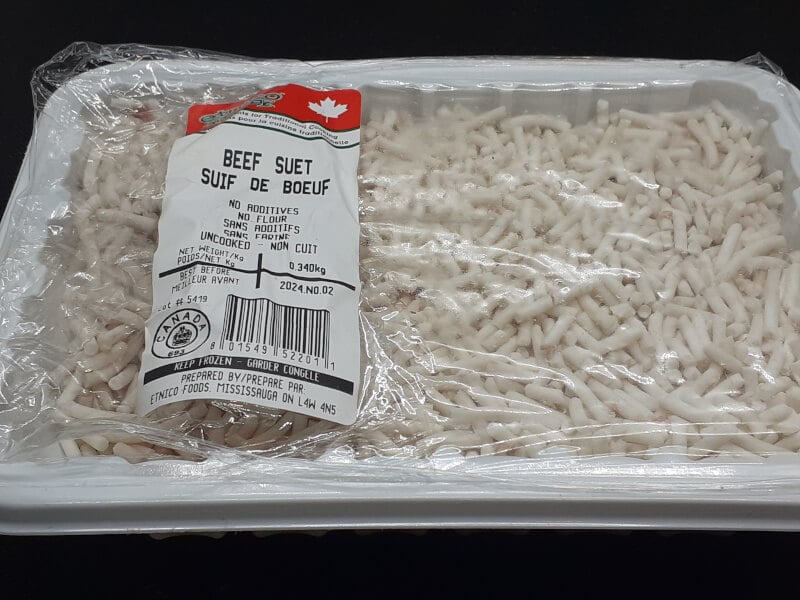
Beef Suet
One of the best fats out there for searing steaks. Just add some to a skillet and heat until hot with a wisp of smoke.
Rendered Steak Fat for searing
I find this to be the best method, since you are rendering out the fat for the protein type you are searing as well as the salted crackling you can snack on and adding so much more flavor to seared meats. All while hitting the best searing temps, and the pan is ready to go as soon as the fat is rendered. No addition of any other fats is needed.
For more information on rendering fat for searing, check out my post on Rendered Fats.

Rendering Beef Fat
Trim the steak of any fat and chop into small pieces. Render out in a skillet over medium to medium low heat until crisp. Scoop out the crackling and discard, or season with a bit of salt and snack on. The rendered fat left behind is perfect for searing and is already hot and ready to go. Turn that heat up to medium – medium high until it starts to smoke and add the steaks in to sear.
Butter vs Ghee
If using butter, it shouldn’t be used to sear, which has a smoke point of 302 F/ 150 C. You will take it way past its smoke point and burn the butter, especially with the pan so hot. It can, however, be added towards the end as long as you keep the butter moving, basting the Steak, and it adds so much. In this case you can take it to a browning stage which is quite nice, with Garlic & Rosemary as well. For searing, Ghee is the best option, which has a higher smoke point at 482 F/250 C.
When adding Oils or Fats, you ideally want to use one with a high smoke point and control the heat, about 400 F. If Butter or Seasoned Butter is desired. Do not sear with it, instead finish it off with the Butter and other ingredients such as Garlic & Rosemary.

Butter
Add Butter after searing to baste the Steaks. Optionally with Garlic & Fresh Herbs.
Cowboy Steaks Cook Method
There are two basic methods for cooking thick (2 inches) Cowboy Steaks at home, besides grilling. Searing and finishing in the oven or reverse searing. Make sure that your steak is completely thawed, seasoned and at room temp. If it is partially frozen or even cooler than room temp, it can result in dry Steak.
Contrary to popular opinion or methods, searing does not lock in juices. It adds flavor & color, which can be done at the beginning or end of the cook by releasing the Natural Fats and Crisping the outside. When searing the steaks directly, the drier the surface of the meat, the better the crust formation.
How to Sear Steak
This method usually involves placing the Steak into the oven after searing to finish cooking until the desired doneness with thicker cuts of meat. With thinner cuts, you can just finish the cooking in the pan until the desired internal temperature.
Start searing by bringing a Heavy Duty Frying Pan or Cast Iron Skillet to temp over medium to medium high heat and wait for the pan to get hot. When you splash a bit of water in it, the water should immediately Bead up and then evaporate. Add a small amount of fat, it should start to smoke. Then add the steaks to sear.
The Steaks should be well seasoned, at room temp and a dry surface for optimal crust formation. Leaving the Steak out while seasoned for an hour will result in the best sear.
Control that heat, if it’s smoking too much, the pan is too hot, and you are burning the fat. Take it off the heat for a bit to calm it down. You should be just staying under the smoke point.
How to Reverse Sear Steak
Reverse sear is when you sear the Steaks after they have cooked in the oven for a bit. This method is best for thicker cuts of meats. One of the reasons why I like this method is that the Fat within the Steak has already softened. When it hits the pan, evaporation of any excess water in the meat happens at a faster rate. The rendered fat is more readily available, giving you a better sear.
Season the steaks and leave out at room temp on a rack with a catch pan for 1 hour while the oven is preheated to 325 F. Place the steaks into the oven to cook until the internal temperature is 10–15 degrees lower than the desired doneness. Then heat a skillet over medium – medium high heat until very hot. Sear the Steak anywhere from 1 to 5 minute each side or to your liking. Some like it just browned, while other like the burnt bits.
For a reverse sear, it is important to keep the pan hot which is why the heat should be closer to medium high and left there until it is really hot before adding the steak, so that it can evaporate the liquids more quickly that seep out with the fat that has already softened.
With doing a Sear first this isn’t needed and so you are able to do a sear at medium heat and wait for the Pan to get really hot before adding the Steak.
Broiled Steak
Place into the oven on broil for a few minutes each side, or until before desired browning. It will brown more as it cooks. Flip the steak over to brown the other side. Then reduce the heat to 325 F – 375 F and cook until desired doneness.
Sear and Bake Steak
Place a Skillet over medium heat and wait for it to get hot. Add Fat and wait for it to start smoking. Sear Steaks anywhere from 3 to 5 minutes per side. Season the seared Side with Salt & Pepper. Repeat for the other side when done searing. Then place into the oven at 325 F-375 F and cook until desired internal temperature. Remove and Rest.
Grilled Steak
I haven’t had a chance to test this method, but it was given to me by a friend who grills up quite a bit of Steaks and swears by this method.
Bring the grill up to 500 F. Grill the first side of a 2″ Steak for 10 minutes. Flip and Grill the other side for 5 minutes for medium rare or a tad longer for medium or medium well. Wrap in tin foil and allow to rest for 10 minutes.
Steak Doneness
As the meat rest, it will rise in temp before dropping, if covered with Tin Foil. If Reverse Searing. Take the meat out about 10 to 15 degrees before your target temp to account for the direct heat that the steak will be exposed to during searing.
The cook times will vary depending on how efficient your heat source is, the thickness of the steaks, If the steaks are at room temp or not and whether it contains the bone or not and other factors. The best method is to measure the internal temp with an oven safe thermometer, where you can read the temp live in real time. This is extremely precise and guarantees your desired outcome every time without fail and with an expensive cut like Prime Rib, you really want to cook this to perfection each and every time.
Steak internal Temperature
Insert the Thermometer on an angle in the center of the meat with no contact of any bones or large pockets of fat, with the Tip at the center of the thickest part of the meat.
- Rare – 120 F – 125 F
- Medium – 140 F – 145 F
- Well Done – 160 F and above
There are various degrees in between as well, with Medium Rare – 130 F – 135 F and Medium Well – 150 F – 155 F.
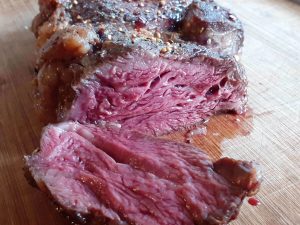
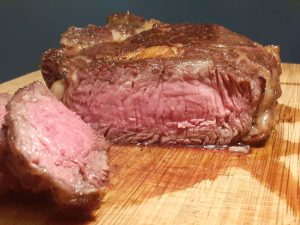

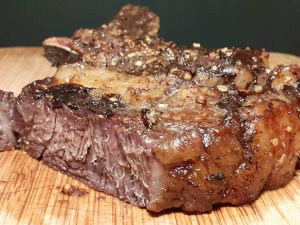
It is always better to be a bit under than over. You can always place the Steak back on the heat to correct. Using an oven safe thermometer, you’ll fair out just fine every time.
Tips for Searing Steaks
- Make sure your steak is completely thawed and at room temp before cooking. The longer you let it rest. The more of an effect the salt will have on the meat and produce a dry surface, which is what you want for searing and color.
- Place the Steaks on a wired rack to maximize surface exposure while leaving out and when reverse searing.
- Use a heavy-duty Pan or Cast Iron Skillet on medium – medium high heat. Ensure that it is really hot with the fat starting to smoke before placing the steak in.
- Don’t touch or move the steak around when searing. Allow to get a good sear, a few minutes each side, or until desired doneness.
- Let the Steak rest either out in the open which will cool the meat down fast, or wrap in tin foil which will cause the meat to still rise in heat more before cooling. The meat will rise in temp when resting by 5–10 degrees.
Equipment
- 1 Oven Safe Thermometer
- 1 Broiler Pan or screen with catch pan
- 1 Large Skillet
Ingredients
- 1 Prime Rib Roast - with 4 bones
Salt & Pepper Blend
- 1 Tbl Kosher Salt - or Sea Salt
- 1 tsp Black Pepper - or Cracked Black Peppercorn
- 1/2 tsp White Pepper - or Cracked White Peppercorn
Instructions
- Cut the Prime Rib Roast in between the Ribs to create 4 Steaks, which will be about 2" Thick. Place Steaks on a broiler pan. Season with Salt & Black Pepper and let rest for a few hours or overnight in the fridge. Before cooking, allow to rest at room temp for an hour or more.
- Place the Steaks into a preheated oven at 325 F and cook until 10–15 degrees before the target temperature with an oven safe thermometer inserted on an angle away from any bones or pockets of fat. Cook anywhere from 20 minutes or more in the case of well done.Rare – 120 F – 125 FMedium Rare – 130 F – 135 FMedium – 140 F – 145 FMedium Well – 150 F – 155 FWell Done – 160 F and aboveFor my 2-inch Steaks, I took mine out of the oven 15 degrees before target temperature, which resulted in a sear of about 5 minutes per side. It all depends on how heavy of a sear you want and what degree of doneness you’re after.
- Preheat a heavy duty frying pan or cast iron skillet over medium – medium high heat until very hot. Add a bit of fat, when the fat starts to smoke, place the Steak in and sear until desired level and flip over to sear the other side. Surface temperature of 400-450 F / 204-232 C. When you sprinkle water, it should bead up and evaporate quickly.Control the heat, if the pan starts smoking too much, you have it too hot and burning the fat. Remove the pan from the heat to cool down and adjust the temp and place it back on the heat.
- If desired, when the Steak is pretty much done searing you can add Butter, Garlic & Rosemary or other fresh Herbs, remove from the heat and constantly baste the Steak to keep everything moving. Remove once the Butter is browned.

